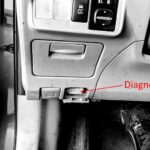Performing an OBD2 drive cycle on your 1996 Chevy Blazer after completing repairs or clearing diagnostic trouble codes is crucial to ensure your vehicle is ready for emissions testing and to verify that the repairs were effective. This process allows your Blazer’s onboard computer to run a complete series of diagnostic tests. Here’s a detailed guide on how to execute a 1996 Blazer Obd2 Drive Cycle correctly.
Performing the 1996 Blazer OBD2 Drive Cycle
To start the OBD2 drive cycle for your 1996 Blazer, ensure the engine is completely cold. This means the coolant temperature should be below 122 degrees Fahrenheit (50 degrees Celsius), and the air and coolant temperature sensors should be within 11 degrees Fahrenheit of each other. It’s important to note that you should not turn the ignition key to the ‘on’ position before starting the engine, as this might prevent the heated oxygen sensor diagnostic from running properly.
-
Cold Start and Initial Idle: Begin by starting the engine. Immediately put the vehicle in drive and let it idle for two and a half minutes. During this phase, turn on the air conditioning and the rear defroster to increase the electrical load. This step allows the OBD2 system to check the oxygen sensor heater circuits, air pump, and EVAP purge system.
-
Acceleration Phase: Turn off the air conditioning and rear defroster. Accelerate smoothly to 55 mph using about half throttle. This acceleration phase is important for the OBD2 system to assess for ignition misfires, fuel trim, and canister purge operation.
-
Maintain Steady Speed: Hold a steady speed of 55 mph for three minutes. During this constant speed, the OBD2 system monitors the Exhaust Gas Recirculation (EGR) system, air pump, oxygen sensors, and canister purge system.
-
Deceleration Phase: Safely decelerate (coast down) from 55 mph to 20 mph without applying the brakes or depressing the clutch. This coasting down allows the OBD2 system to check the EGR and purge functions under deceleration conditions.
-
Second Acceleration: Accelerate again back to a speed between 55 and 60 mph using half throttle. This second acceleration re-checks for misfires, fuel trim, and purge system efficiency.
-
Extended Steady Speed: Maintain a steady speed between 55 and 60 mph for five minutes. In this extended steady-state driving, the OBD2 system evaluates the catalytic converter efficiency, misfires, EGR system, fuel trim, oxygen sensors, and purge functions more thoroughly.
-
Final Deceleration and Stop: Decelerate (coast down) to a complete stop without using the brakes. This final coast down enables the OBD2 system to perform a final check of the EGR and canister purge systems.
By completing these steps, you allow the 1996 Blazer OBD2 system to run all necessary diagnostic checks. After successfully performing the drive cycle, the system status flags should be set, indicating whether your vehicle has passed all emissions-related tests or if further diagnostics and repairs are needed. This process is essential for ensuring your 1996 Blazer is running efficiently and environmentally responsibly.
